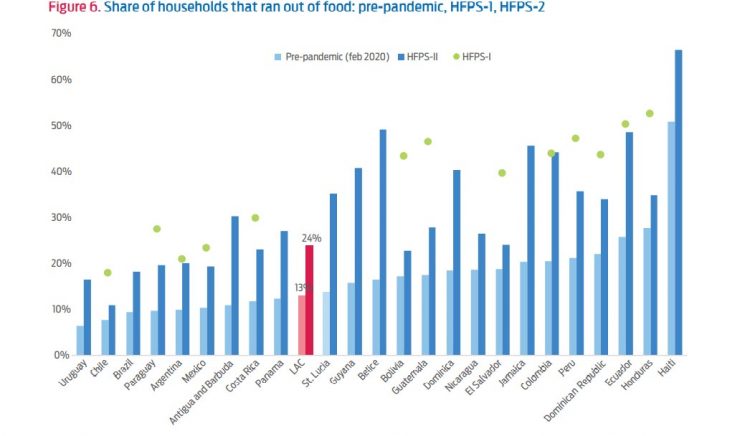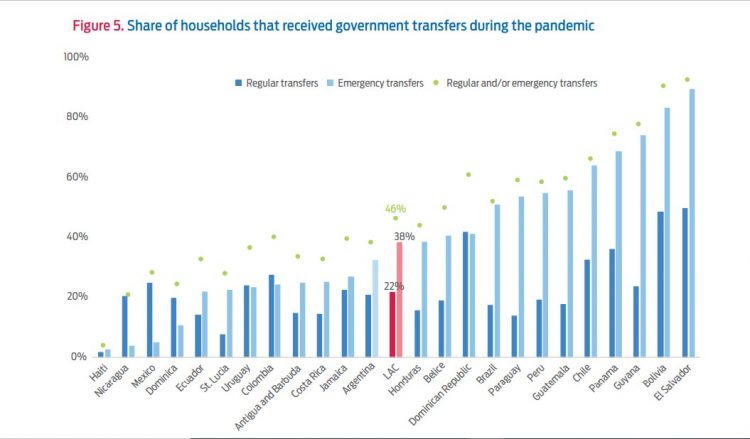With the COVID-19 pandemic continuing to batter the world, putting more people at risk of unemployment and hunger, a recent World Bank report has identified Guyana as being among Caribbean countries that face worrisome levels of food insecurity.
The report, “An Uneven Recovery: Taking the Pulse of Latin America and the Caribbean Following the Pandemic,” is a result of a collaboration between the World Bank and the United Nations Development Program (UNDP) based on surveys conducted in 24 Latin American and the Caribbean (LAC) countries.
The surveys, conducted between May and July of this year, found that as a consequence of labour market setbacks, just over half of the households in the region have not yet managed to recover their pre-pandemic income levels. The inability of the households to return their income levels to pre-pandemic levels puts their food security at risk.


The surveys demonstrated that food insecurity still affects 23.9% of households in Latin America and the Caribbean, which mean that the pre-pandemic food insecurity figure of 12.8% was almost doubled. It also found that the countries with greater inequality and poverty experienced bigger food insecurity shocks.
Of the surveyed countries, 24% of households across LAC reported having run out of food due to lack of money or other resources, as opposed to 13% before the start of the pandemic. The report noted that all of the surveyed countries appear to be worse off after the pandemic, and those with higher inequality and poverty have endured the largest increases in food insecurity.
“Caribbean countries such as Haiti, Jamaica, Dominica, St Lucia, Guyana, and Belize face particularly worrisome levels of food insecurity. For some countries, a visible recovery with respect to the outlook in mid-2020 is observed: Bolivia, Guatemala, and Honduras have displayed the most significant declines in the incidence of food insecurity (21, 18, and 18 pp – percentage point – respectively). On the other hand, the situation in Argentina, Colombia, and Ecuador remains worrisome yet stable, with households facing similar levels of food insecurity as they did at the onset of the pandemic in 2020,” the report notes.
Income setbacks and cash transfers
The World Bank report says that the negative impacts of COVID-19 on the labour market have resulted in more families facing the possibility of going hungry. Of the surveyed countries, very few showed visible recovery as households are now reporting income increases. The report related that economic turmoil for households in the LAC region persisted despite governments’ attempts to counter it through expansions in coverage and expenditure of regular social transfers and the introduction of emergency transfers. It noted that some 46% of households in the region benefited from regular social and emergency cash transfers.
Guyana falls within the top three bracket of countries whose citizens benefitted from emergency and or regular transfers as a cushioning mechanism during the pandemic. Almost 80% of Guyana reported receiving some form of assistance according to the World Bank.
After taking office in August of 2020, the Irfaan Ali-led administration introduced a series of one-off cash transfers to provide some relief. They included the one-off $25,000 COVID-19 cash grant to households, as well as cash grants for school children, flood relief to farmers and other forms of assistance.
Survey results demonstrate that the crisis particularly affected women, both because of the stronger initial impact on them and their slower labour market recovery. It found that mothers of young children (aged 0 to 5 years) have been most affected while revealing that women are twice as likely as men to be unemployed owing to the pandemic.
“As of 2021, women in the region are twice as likely as men to have lost their pre-pandemic jobs. This is partly explained by the weak recovery of sectors in which women are predominantly employed: the services sector and other activities where personal interaction is fundamental. Job losses for fathers of young children is one-third the rate experienced by mothers with similarly aged children. Unfortunately, more than half of the women who lost their job have exited the labour market altogether, thereby significantly reducing female labour force participation in the region” the report notes.
For the region as a whole, the employment rate stood at around 62%, almost 11 percentage points below the pre-pandemic level. Apart from lower employment levels, there has also been a deterioration in the quality of jobs available in the labour market.
Lowest levels of educational engagement
While the Ministry of Education is currently overseeing the phased reopening of schools, the World Bank report found that Guyana was among the countries with the lowest levels of educational engagement.
“The lowest levels of engagement are observed in Guatemala, Guyana, and Belize, with only two-thirds of school-age children engaged in some form of education. Many countries are highly reliant on remote learning options to keep children engaged, such as Chile, Peru, Panama, and Ecuador,” the report states.
The report adds that most children are engaged in some form of educational activity in the region but the figures suggest severe learning losses and an increase in dropout rates. It concluded that the learning losses and increased school dropout rates present grave implications for the accumulation of human capital.
“More than one year into the pandemic, only 23% of students in the region were attending school in person…children in wealthier households, measured by the number of assets, are more likely to be engaged in schooling, but their attendance is also mostly virtual. Lower engagement in learning activities and low face-to-face attendance pose significant risks for children’s learning outcomes and human capital accumulation. Recent estimates reveal that students in the region lost between 12 and 18 months of schooling. Those from low socio-economic levels were particularly affected, which suggests long-lasting negative effects on social mobility and inequality,” the report further states.





